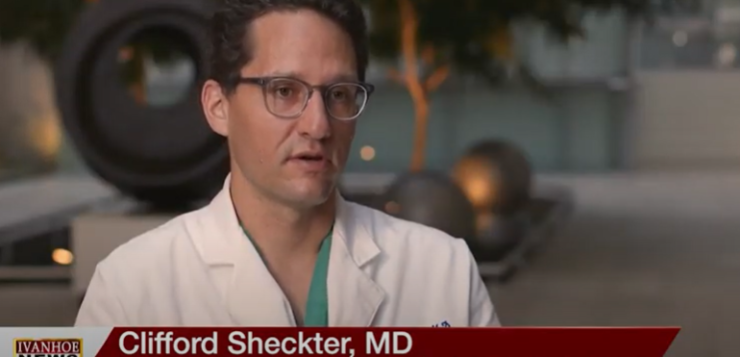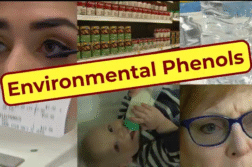Dr. Clifford Sheckter, MD, burn and plastic surgeon at Santa Clara Valley Medical Center, associate director of the burn center, and assistant professor of surgery at Stanford, talks about a new treatment that uses a person’s skin cells to grow their own skin after a tragedy.
Interview conducted by Ivanhoe Broadcast News in May 2022.
What happened to Rogelio? Did he accidentally set himself on fire?
DR SHECKTER: It’s unclear the exact circumstances, all we know is that our local firefighters found him on fire and unconscious with his lower body and chest burning.
Was he at his house?
DR SHECKTER: He describes being near a school when this happened. It’s unclear how far that is from where he was living at the time. I really don’t know much. Rogelio can describe how he thinks he was burned, but to be totally honest, I think we can only speak to what the authorities’ report is, which is they found him not too far from a school on fire.
Would you describe his injuries as catastrophic? Did your team expect that he was even going to be able to pull through this?
DR SHECKTER: Yeah. He had very severe injuries. So, 65 to 70% of his total body surface area was burned and the depths of his burn were particularly deep. So, usually, people talk about burns on depths of second and third degree. But for Rogelio, the burns to his legs in particular we’d say were fifth or sixth degree, meaning they go all the way down through fat, through muscle and fascia, and the bones in his lower legs were burned. So, a very profound injury.
So, the burns weren’t on his face at all, just the trunk and the legs?
DR SHECKTER: Correct. He had some burns to his face, to his arms, and then essentially, was burned from just below the nipple line all the way down through and to his feet.
Was he unconscious? Could he speak?
DR SHECKTER: When he came in, he was intubated immediately to protect his airway and to provide him lifesaving support at that time. He was very ill when he came to us.
What were his chances of surviving?
DR SHECKTER: The prediction models we use for survival and burn are based on the Baux scoring system. If you look at his age, which is a gentleman in his mid-50s, the percentage of his body that was burned and, in addition, having an element of injury to his lungs from smoke, his chance of survival would be estimated around 20%.
Once he came in and was intubated, what was the next step? Was it surgery?
DR SHECKTER: For a burn of that size, the next step is going to be resuscitation. The physiology of a burn leads to massive losses in fluid, so, your intravascular fluid volume essentially all just leaks out into your tissues. You have to give all of that volume back to prevent the patient from being in life-threatening shock and cardiac arrest. So, his initial period was an intensive resuscitation. He also had profoundly deep burns to his legs and onto his chest. So, in order to maintain blood perfusion to those extremities, we had to incise the eschar – cut open what is basically leather tissue at that point to allow perfusion to his legs and to his feet.
Was all the cutting considered the surgery?
DR SHECKTER: Yeah. Whether you call it a surgery or procedure, that was something performed emergently after being intubated, having those incisions placed onto his legs. And then, I would also mention that he had severe burns to his perineum and to his genitals, which was prohibitory in placing a foley catheter, as we usually would in somebody who’s very ill in ICU. Our colleagues in urology actually had to place a catheter through his abdomen above his pubic bone to get to his bladder, which is something very rarely done in a burn injury.
Did Rogelio have nine surgeries total?
DR SHECKTER: Yeah. After a period of resuscitation, which takes 24 to 48 hours, we proceed with removing all the dead tissue over his body. Then, once that’s removed, there’s a sequence of operations to get new skin on him to heal him.
Was that where the EpiCel comes in?
DR SHECKTER: Once his wounds were excised and we felt the wound bed to be healthy enough, this is where we leverage the technology – cultured epidermal autographs, so, taking a piece of his skin, sending it off to a laboratory, growing large sheets of epidermis, which were then placed over a large proportion of his burns – essentially his whole entire torso and most of his legs.
Typically, when a patient is burned, you just do skin grafts, but Rogelio was severely burned. So, what’s the advantage of EpiCel over the skin grafts?
DR SHECKTER: The EpiCel, or the cultured epidermal autographs, were used in conjunction with skin grafting. So, the technology grows the epidermis, which is the outer part of our skin, but it does not grow the dermis, which is the meaty white part of our skin. If you think about having 70% of your body lose its skin, you only have 30% of your skin available to take to heal the rest of that. So, it requires taking skin grafts, expanding those grafts very widely. Those grafts, at that point, are too wide to heal on their own. So, you place the EpiCel on top of those grafts and it allows him to heal. This was exactly what we did in his case, and it was successful.
So, are the EpiCels only the top layer?
DR SHECKTER: That’s exactly right.
Can you ever do EpiCel just on its own?
DR SHECKTER: No.
How does EpiCel work?
DR SHECKTER: When we think about the outer layer of our skin, it’s called the epidermis. It is one of the few tissues in our body that can regenerate, meaning it can regrow and replicate itself. Many other tissues in our bodies cannot do that. They instead scar or change into a tissue type that is not the same as what it was initially. So, what they’re able to do in the laboratory – and this is a technology that’s been around for a few decades – is to find those cells. They’re essentially a type of stem cell – a progenitor cell that can give rise to more epidermis, and they’re able to grow that on sheets in an environment that is conducive to these cells proliferating and make massive sheets of epidermis.
Since it’s on the top layer, would it look like my skin?
DR SHECKTER: It does not. Our skin is dry, and that’s because it has a protein on it called keratin that gives it its strength and its dryness. When we receive the cells from the laboratory, they’re very fragile, so, they’re placed on a piece of parchment-like paper. The best way to describe it, it almost like a pink film of almost tissue paper thickness. It’s very thin and fragile. We sequentially place those grafts on top of the widely meshed skin graft that we took from Rogelio. Some of the areas on his body that were not burned would be the upper arms and his scalp. We used his scalp and his arms as his widely meshed graphs and then placed the EpiCel on top of those.
How long did all this take?
DR SHECKTER: Rogelio was in the burn unit for around two and a half months. The big operation of using the EpiCel – that operation itself took about two and a half hours. It was a great concerted effort. We have three burn surgeons here at Santa Clara Valley Medical Center and all three of us worked as quickly as possible, because Rogelio was fighting sepsis at that point and had very unstable blood pressures. So, we moved as quickly as we could. Being under anesthesia can make that worse and, thankfully, it was successful.
Are there less surgeries involved if you just did skin grafting alone?
DR SHECKTER: Yes. In order to heal the surface area that he had injured and had no skin; you have to expand the skin grafts. The best way to describe it as I do to my patients is it looks like wide fishnet stockings. The degree to which we mesh them, they can’t heal on their own because the gaps are so wide. So, if you’re not going to use EpiCel, you can’t tackle surface areas as large as he had. You’d have to go after much smaller surface areas, use grafts that are much smaller, wait for the donor sites to heal, and then repeat that process every 3 to 4 weeks. I think one reason why Rogelio’s burn of his size – he was able to leave the hospital in what is considered a relatively short period of time for a burn of that size is because, in one of these large operations, we were able to cover such a significant portion of his wounds and heal him.
What would have been the options?
DR SHECKTER: Well, donor skin, or cadaver skin, works as a temporary measure for wounds. The problem is, just like any other organ transplant, whether it’s a liver or a kidney, skin from a donor will get rejected by the body and it cannot heal the wounds. When we have patients that we don’t have sufficient skin or if we don’t use EpiCel, we temporize with donor skin until we have enough of the patient’s own skin to heal those areas. I think in Rogelio’s case, if we did not have access to EpiCel, his hospital course would have been a lot more prolonged, there would’ve been more operations. And for him, he had episodes of sepsis from his wounds, and that is what kills our burn patients after they make it through the acute resuscitation phase. They get overwhelming wound sepsis, and they die from that. So, you are up against the clock in trying to get the patient’s wounds healed as quickly as possible because, if you don’t, they will die from infection in their wounds.
So, appearance-wise, is it basically the same?
DR SHECKTER: The healed areas are very different from normal skin. They lack the appendages of normal skin – so appendages being sweat glands, hair follicles. So, on the areas where he is healed, he’s not able to have good temperature regulation because he can’t sweat, and he has no hair. Then, the tissue itself is very scar-like in the sense that it is more rigid, it’s less pliable, and the appearance of it has colors that are different from the normal skin. The process of these healed grafts go through different phases, but initially, they’re often very pink and then they turn into a grayer color over time, but it’s often hard to predict how they’re going to look in the long run. I would also add that that skin has an element of a meshed appearance forever. But the skin has an appearance of those areas where the EpiCel healed in the gaps of the meshed skin graft.
How is EpiCel a game-changer?
DR SHECKTER: EpiCel allows you the opportunity, in one operation for a burn of this size, to heal a significant portion. So, for example, in the operation we used, we were able to heal about one-third of his total body with one operation, and that is not possible in a burn of this size without using that technology.
Did Rogelio exceed your expectations?
DR SHECKTER: Given that Rogelio came into in the O.R. sick that day – he was septic, he was on pressers – so, blood pressure medicines that are maintaining his blood pressure that otherwise would be life-threatening – the fact that all the EpiCel took and healed without any additional surgeries to those areas far exceeded our expectations. And I’m very happy how that went.
What did the rehab process entail for Rogelio?
DR SHECKTER: Well, a burn of this size means you’re going to be in the hospital for months, and that can be quite debilitating for many reasons. You’re also learning to cope with new skin. Many burn survivors will say that they feel like they’re getting adjusted to a new body. So, learning to do simple tasks, such as get yourself dressed to eat – the activities of daily living are challenging. You have to relearn a lot of that. We’re so fortunate at our burn center to be in the same building as a nationally renowned rehabilitative center. At other burn centers, they have to ship their patients off to another building and don’t have quite the relationship we have here. We have a very close relationship with our rehabilitative medicine group. And that seamless transition and their investment in burn survivor care is what allowed Rogelio to be walking, ambulating, and to leave the hospital as he did just over a week ago.
How long does the process of growing the skin take?
DR SHECKTER: It takes about three weeks.
So, does that cover all the steps?
DR SHECKTER: The steps are excising the dead tissue, getting the wound bed healthy with blood supply, with the least amount of bacteria in it as possible, and then placing very widely meshed grafts and then placing the EpiCel on top of that. Essentially, they can store the skin for a little bit longer. There’s a little bit of wiggle room – three, four weeks. Certainly, no sooner than three weeks though.
After the EpiCel two-and-a-half-hour surgery, did Rogelio have to have other surgeries as well?
DR SHECKTER: He did. For the parts of his burns that were profoundly deep on his lower legs where he had bone exposed, that required additional operations. We call them dermal substitute products to grow tissue on the bone that is going to then allow grafts to take. From there, we used a product called Integra that allows us to do that. It’s a product that’s comprised of shark-like tissues, like, glycosaminoglycans, and then, bovine or cow collagen. So, that was another technology that was very important to use in his case.
How is Rogelio doing today?
DR SHECKTER: Rogelio is doing well today. I mean, he had a catheter going into his abdomen to drain his urine. He had to have a tracheostomy during his care and, essentially, wasn’t able to speak or have much awareness for months. Now, Rogelio has since been decannulated, he’s speaking, he’s able to void naturally, that catheter’s out of his abdomen, and he’s able to ambulate with assistance, get himself dressed, and importantly, has a very positive outlook on all of this. And we can’t ask for more than that. I’d say that is the absolute best outcome from an injury of this severity.
Do you think he’s a fighter?
DR SHECKTER: Oh, Rogelio’s absolutely a fighter. I can’t stress enough how sick he was during his hospitalization. I mean, he had ARDS, a severe form of respiratory failure, and to be able to pull through all of that – nine operations and then, most importantly, to really fight hard in therapy to get mobility back, to want to walk again, to want to eat again, to want to speak and do all these things. That’s not possible unless you have a lot of drive and will, and that’s exactly what he had.
Is there anything else you want to add?
DR SHECKTER: I would just add that recovering somebody from this severe of an injury takes an army of people. I mean, there’s multiple specialties involved in his care – plastic surgeons such as myself who do burn. And I said, there’s three of us in our group that all worked on him. Intensivists as part of our surgical critical care group here. And then, in this case, urology, ENT, the anesthesiologists who participated in all his cases, and then, the nursing care. I mean, the amount of nursing care and nursing hours that goes into all the dressing changes. You have one-to-one ratios of nurses taking care of his grafts, keeping infection at bay. It’s hard for me to even comprehend and count – hundreds, thousands of nursing hours dedicated to one person. And that’s just a level of dedication that you don’t see anywhere else in medicine, I can promise you that. And then, to have the rehabilitative group here to take him on and, once again, spend hundreds of hours working with him to get him to walk again and be independent – it’s a profound commitment.
END OF INTERVIEW
This information is intended for additional research purposes only. It is not to be used as a prescription or advice from Ivanhoe Broadcast News, Inc. or any medical professional interviewed. Ivanhoe Broadcast News, Inc. assumes no responsibility for the depth or accuracy of physician statements. Procedures or medicines apply to different people and medical factors; always consult your physician on medical matters.
If you would like more information, please contact:
James Chisum
(562) 493-6023
Sign up for a free weekly e-mail on Medical Breakthroughs called First to Know by clicking here




